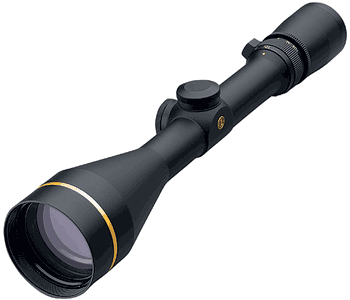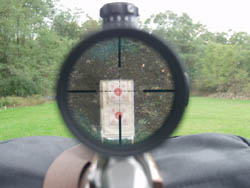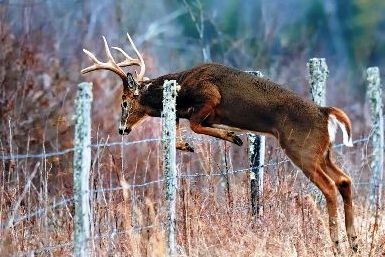If you hunt white-tailed deer, or any other big game animal for that matter, at some point you will need a quality rifle scope. This article is intended to give you a few suggestions and tips to keep in mind when making your final selection. First, find a quality scope that fits in your budget. And I suggest buying the best you can afford. Unless you are in the habitat of buying guns every year (then I want your job), you will probably only buy a handful of scopes throughout your hunting life. With that said, you will never go wrong buying the best YOU can afford.
First, an important aspect of rifle scopes is light gathering quality of the scope. To check this out, look at the large end of the scope. The diameter of the scope lense will be measured in millimeters (mm). The larger the objective lens the more light it will ultimately gather. If you are hunting early morning or late evening, and who isn’t, you need to gather as much light as possible.

A scope size will look like 9×35 or 9×40 or 10×50. The first number gives you the scope power. It simply means that objects viewed through the scope will appear 10 times closer than what you can see with your eye if you are using a 10×50 scope. The second number will give the objective diameter of the lens. In this case, it would be 50 mm. The objective is where you gather light. The larger the objective lens, the more light it gathers.
Now, the example above works for a fixed magnification scope. However, I use a rifle scope that has adjustable magnification. A scope described as 3-9×50 means that magnification is adjustable from 3 power to 9 power magnification. The scope set on 4 power will give you wider field of view, but less magnification.
If you are shooting at a moving target or hunting in tight quarters then lower magnification is best. It will make it easier to track your moving target. The higher the magnification, the more narrow the FOV. If you expect to shot at game 100 or 200-yards away, crank the scope over to 9 power. The scope basically works just like the zoom on a camera lense.

Next, make sure the scope has multiple coated lens. This means that each lens in the rifle scope has multiple coatings which will reduce the loss of light, provides a higher contrast image, and also reduces glare. There are different types of coatings used and the type of coating depends on the manufacturer. Obviously, more expensive scopes use better coatings which result in better products.
Next, your new scope should have windage and elevation adjustments if you are a long-range hunter (300+ yards). These are the dial protrusions on the top and the side. The top adjustment should be the elevation or up/down adjustment. The windage or left/right is commonly on the right side of the scope. Each of can be change by removing the protective cap and turning with your fingers. Each click generally results in ¼” change at 100 yards. These clicks are fairly easy to hear, but make sure you are familar with your scope before heading out into the field.
The next thing to consider is the exit pupil size -that is the end of the scope nearest your eye. Once again, the larger the exit pupil size the brighter the image appear. Normally you can divide the magnification power by the objective lens to find the exit pupil size. A 10×50 would then give you a 5 mm exit pupil. In other words, the size of the column of light that comes out of the exit pupil lens.
An important consideration is also the eye relief of a scope. Eye relief refers to how far your eye can be from the end of the scope and still give you a full field of view (FOV). With a long eye relief you can be farther from the end of the scope. If you are too close, the rifle recoil may cause the scope to hit your eyebrow, causing a cut or a bruise. If you choose a scope with a fairly short eye relief, make sure it has soft rubber surround on the back end of the scope. This will give a little more protection from the recoil should the scope come in contact with your head. But I suggest avoiding this potential problem all together and going with a longer eye relief.
And with all that in mind, be sure to find a scope that is sealed, waterproof and fog proof, and one that is scratch resistant. Drops, falls, and crashing through brush can all scratch your scope. There are many manufacturers of rifle scopes and even more models of rifle scopes, but look around, compare prices and features, get it mounted on your gun, and get out in the woods!

Thanks for these very interesting points you make. I just bought a cheap Chinese Visionking brand 3 days ago that has a 3x9x44 magnification. Only now I know what those numbers are for. Thanks anyway.